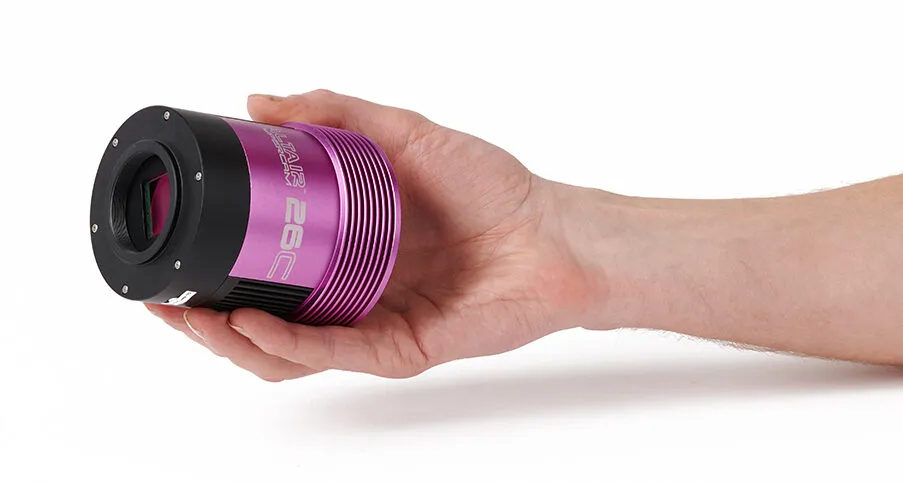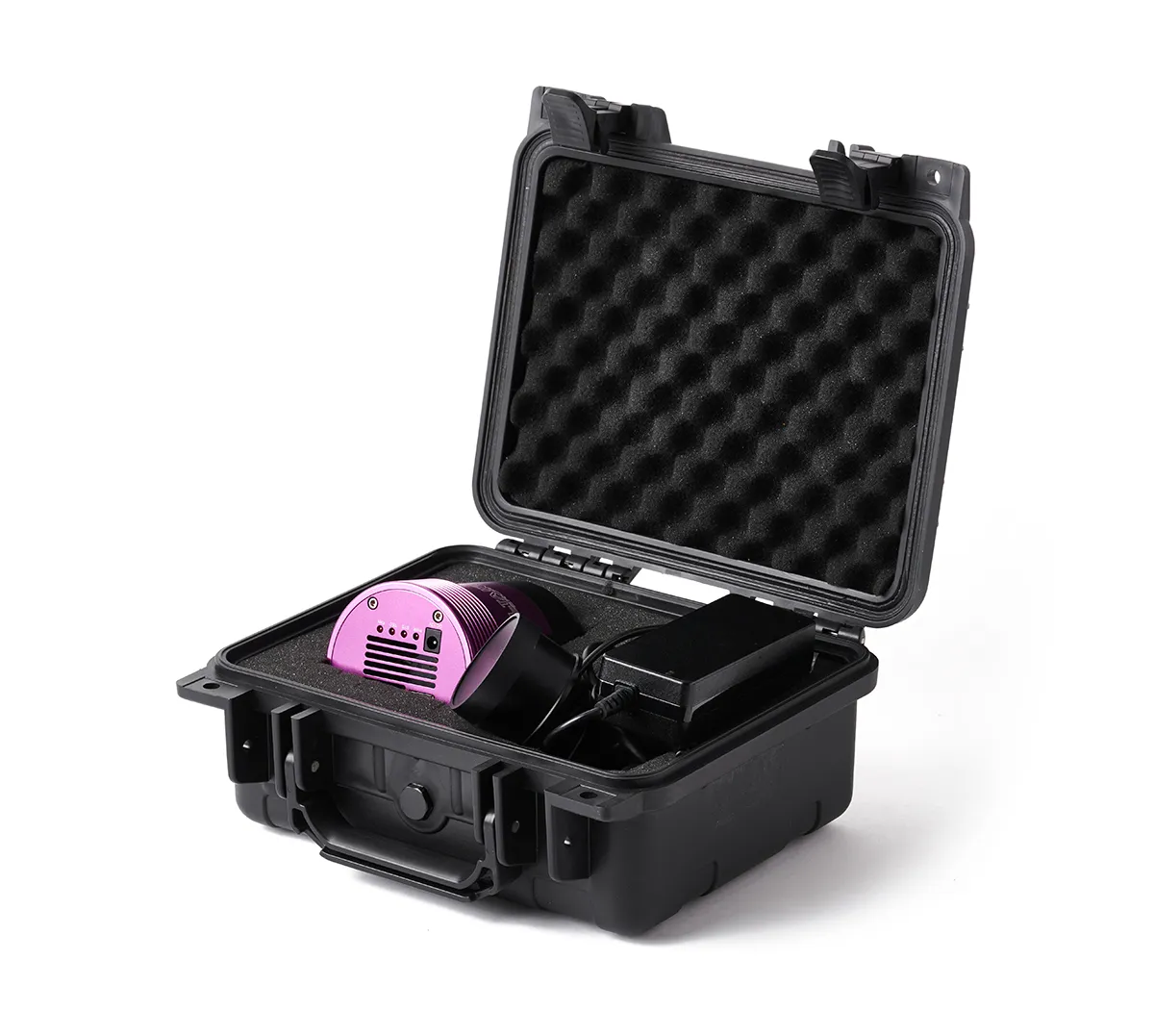Altair Astro has entered the emerging 16-bit astronomy camera market with its new Hypercam 26C colour camera. A significant upgrade over previous models, it has a large APS-C-sized sensor with 512MB of built-in DDR memory and produces full colour 26MB images.
Although the Hypercam 26C features a CMOS sensor designed for DSLR cameras, it retains a reasonably slender, circular design and is surprisingly lightweight. We fitted the camera to our filter wheel via the standard M42 thread on the camera’s front.
There’s no need for infrared and ultraviolet blocking filters, though, thanks to the optical window in front of the CMOS sensor that blocks these wavelengths. But if you use a light pollution filter or one of the newer duo, tri, or quad bandwidth filters, you’ll need a 2-inch version to cover the sensor.
This camera is on our list of the best cameras for astrophotography.

There was no software supplied in the box with the camera, but a simple download from the Altair Astro website installed the camera drivers along with image-capture software.
We also downloaded the ASCOM driver for the camera (ASCOM being the industry-standard interface that allows different pieces of astronomical equipment to communicate) so that we could use it with our preferred observatory program.
Although the ASCOM driver allowed basic use of the camera it was a bit clunky and some features were unavailable, most notably the controls for the heated optical window, so at times we reverted to the supplied software for captures.
Our observatory uses USB 2.0 hubs. These ran the camera perfectly, but data transfer is more efficient in USB 3.0 mode and frame rates are improved, so it would have been good to see that as an option on the camera.

After allowing a few minutes for the cooling system to stabilise we chose a familiar target, the Pleiades, M45, to take some test images and to get a feel for the exposure settings to use on the camera.
From the outset it became clear that this 16-bit camera is very different to the 12-bit models we have reviewed previously.
With a wide range of available configurations governing exposure length and gain settings, we felt it would take us quite a number of clear nights experimenting to determine the optimal settings for each target.
With a set time limit for the review we decided to use just three arbitrary gain settings to ensure we got a selection of useable photographs, but we think the camera is likely to be capable of much better results than we achieved during our time with it, which was hindered in part by cloud and wet weather.
That said, with some notable high-dynamic-range targets available in the sky – namely the Orion Nebula, M42, and the Andromeda Galaxy, M31 – it gave the camera a chance to demonstrate what it could do on a single target that has an extreme variance between its brightest and faintest areas.

It was especially pleasing to see that the Trapezium Cluster within the Orion Nebula was captured in great detail without blowing out the individual stars, while in the same exposure the much fainter gas clouds and nebulosity were also revealed.
We found the same was true for M31, with the bright core of the galaxy showing nice detail along with good structure in the dark dust lanes further from the core.
We feel the results obtained from the camera demonstrate that it would allow our equipment to produce images representing the very best that the prevailing conditions could allow.
The Hypercam 26C is particularly well suited for long exposure deep-sky astrophotography. While it is possible to select a smaller region of interest to work with, the camera isn’t ideal for planetary imaging, and in full-frame mode the captured file sizes really start to add up, with each individual RAW file taking up nearly 50MB of disk space.
In turn this means that a reasonably decent specification computer is desirable for post-processing the large files you get from a stacked imaging run.
To sum up, we found that the Hypercam 26C offered top-quality full colour photographs at the upper limit of what our equipment and sky quality permitted. Indeed, it proved itself to be a highly capable camera.

Altair Hypercam 26C's sensor
With 6,224 x 4,168 pixels, the Sony CMOS sensor in the Hypercam 26C APS-C offers plenty of imaging real estate, with 28.3mm across the diagonal, making it ideally suited to telescopes offering a larger, coma-free image circle.
Aside from an increased image area to work with, what sets the IMX571 sensor apart from the majority of astro cameras is its true 16-bit capability.
This allows the camera to capture over 65,000 levels of intensity within an image, making it ideally suited for astrophotography, where – unlike standard daytime photography – we are looking to extract the faintest hidden details and the brightest of stars from within the captured data.
Noise (unwanted artefacts) is kept to a minimum in the back-lit Sony sensor, allowing higher gain settings to be used for speedier image acquisition, without compromising on image quality.
With a given peak Qe (Quantum efficiency) of 80%, the 26C easily collects data from the faintest objects, revealing hidden galaxies and delicate nebulosity within images.
Altair Hypercam 26C: outstanding features
Thermo Electric Cooling (TEC) system
Camera sensors produce heat, especially during long exposures, which can result in noise (unwanted artefacts) in images. The Hypercam 26C is capable of cooling the camera to 35°C below ambient temperature. This allows the user to set a working temperature that is achievable all year round, which is ideal for taking a matching dark frame library.
Capture software
Altair supplies a dedicated imaging program, AltairCapture, to use with the Hypercam 26C, which is downloadable from the Altair Astro website.This allows you to control every aspect of the camera, and easily adjust gain, bit depth, exposure length, cooling and heating options, region of interest imaging, plus many more aspects including live focusing routines.
Heated optical window
In front of the CMOS sensor there is an optical window for blocking infrared and ultraviolet light. In certain damp conditions cooled cameras can suffer from dew spots that form on the window, which are difficult to remove and can spoil the images. The Hypercam is equipped with a controllable heating element which alleviates this issue.
USB 2.0 hub
Multiple tangled cables are a nightmare for astrophotographers. On the rear of the camera there are two USB 2.0 sockets, which can be used with light, short cables for low bandwidth accessories like filter wheels, to cut down on cable weight and clutter.
Armoured case
The camera is supplied with a sturdy black ABS (hard plastic) case that makes it safe to transport and store the camera. This includes foam inserts with cut-outs for the camera, power supply and cables. For added security, the design will accommodate dual padlocks.
Vital stats
- Price £1,799
- Size 108mm x 85mm diameter
- Sensor Sony IMX571
- Resolution 26MP, 6,224 x 4,168 pixels
- DDR memory 512MB
- Exposure range 0.1 ms – 3,600 seconds
- Power 12V DC (supplied)
- Weight 0.6kg
- Supplier Altair Astro
- Tel 01263 731505
- www.altairastro.com
This review originally appeared in the March 2021 issue of BBC Sky at Night Magazine.
